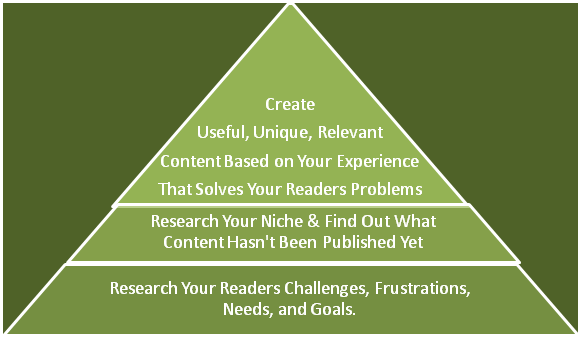It’s interesting to read about the different ways bloggers and online marketers go about creating content.
Based on my own experience reading posts about how to blog and write useful content, i have learn’t that what comes natural works the best.
If you’re helpful by nature, you can provide the answers people are searching for or work out the best answer and provide it.
This simple pyramid shows the heirachy which i think is important to keep in mind when you are creating new content.
It’s one way to create content that’s:
- relevant
- useful
- unique
If you don’t think it works or you would like to add to this post, please do so in the comments.

What i haven’t included in this image is SEO and what comes after publishing your content like social media marketing, promotion,email marketing etc.
These help you gather information for the foundation of your content.
Here’s an article which digs deeper into the habits of effective bloggers you will find very useful.
Foundation
I believe the foundation of useful content focuses on understanding your readers:
- challenges
- frustrations
- needs
- goals
Many successful bloggers are excellent at researching and understanding these problems in their niche.
You certainly should learn to understand these problems within your own niche, if you don’t, then maybe its time to learn how to understand your what your readers want.
You can also use comments, direct email contact, surveys and social media engagement to understand your readers problems better.
No point in writing content that your followers don’t need help with or find useful.
Are you writing for search engines or writing for people?
Content Creation
In my opinion, doing research to find what others have written on the same topic before you start writing can be harmful.
You can always find out whats not already indexed which is a good idea or write about a particular topic from a totally different perspective.
It should be based on your own experience and something you’ve worked out how to do which has solved a problem.
Solving Problems
This comes back to the foundation of your content based on the research and understanding your readers.
- Solving problems that your readers are challenged with
- Providing solutions that relieve their frustration
- Giving them the tools or solutions to satisfy their needs
- Helping them achieve their goals
Then your content is ready to be published, promoted using email marketing, social media, engaged in comments & forums and analyzed for improvement using stats.
Comments & Engagement
I’ve taken a look at several Pro Blogger sites and seen there’s been no growth in subscribers over the last year and a big drop in traffic levels. Why?
Here’s my opinion on why.
One of Matt Mullenweg’s most popular posts on ma.tt is about how to kill your community.
- Don’t reply to their comments
- No matter how loyal and regular your readers comment, keep them waiting in moderation like a spammer
- Don’t approve real conversation & constructive debate when a loyal reader speaks their mind
- Don’t allow your readers to put all their cards on the table in a professional manner even though you know they are a part of your niche
- Delete any readers comments that aren’t full of praise so all your comments are positive
If you don’t engage with your readers by replying to their comments, how do you research your audience and gain valuable feedback so you know what to base your content on?
You may not get many comments and i know many big blogs that don’t which are successful.
You may be connecting or gathering information to build your content on in other ways like:
- Through any social media network
- Direct email contact
- Surveys
Feedback
How about you.
What’s the foundation for your content and how do you research your audience to find out their challenges, frustrations, needs, goals.

Leave a Reply
You must be logged in to post a comment.